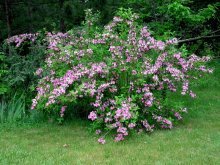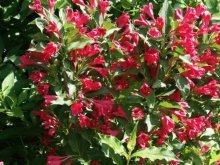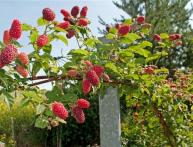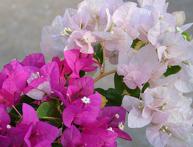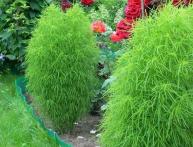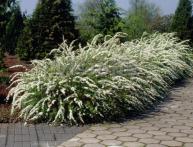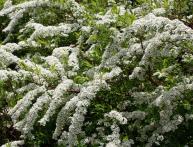The mysterious sounds of bells of Weigela hybrida

Looking at the amazingly beautiful bell-shaped flowers decorating a tall bush with bright foliage, it seems that they actually sound. Their gentle melody creates a special atmosphere of comfort in an area of any size. A person who sees this plant in all its glory will definitely want to grow it at home.
Currently, with a large number of companies specializing in the sale of ornamental shrubs, finding a plant called weigela hybrida is not so difficult. The main thing is to know what to buy and how to properly care for it. Any experience and advice on caring for flowering herbaceous perennials from the honeysuckle family will be useful.
Content:
- General requirements for growing hybrid weigela
- Flower propagation
- Pruning and feeding
- Varieties of hybrid weigela
General growing requirements
Almost all plant varieties They love well-lit planting sites. In the shade of large trees, hybrid weigela develops much more slowly and rarely blooms. The process of lignification of shoots is delayed and becomes weak, which leads to their freezing and death in winter.
The seeds practically do not ripen. Cold northern winds should not have an advantage in the place where the shrub is planted, since the wind damages not only the flowers, but also the delicate leaves of the weigela, which does not improve its decorative qualities.
The size and number of bells greatly depends on the fertility of the soil and its general condition.Therefore, rotted compost, turf soil and mineral fertilizers, which include phosphorus and potassium, are added to the planting pit. Acidic soils require preliminary autumn liming. It is better to plant in the spring.
Seedlings purchased in the fall must be buried and well covered. Loosening and mulching of bushes should be done regularly. Stagnation of water under the roots of the plant is not allowed. If such a danger exists, then high-quality drainage must be done. Moreover, the layer of sand and gravel should be at least 15 cm. All varieties of shrubs require regular watering, but without waterlogging, during active growth and flowering.
Excess water affects the appearance of weigela and can lead to its death. The condition of the root system is very important and is immediately reflected in the appearance, especially of young plants. The appearance of yellowness of the branches and the cessation of their growth are signs of a lack of moisture or the appearance of mole crickets and May beetle larvae. It is urgent to take measures to treat the entire bush with insecticides.
The plant does not belong to winter-hardy species, and therefore requires shelter for the winter months. It is recommended to tilt the branches towards the ground. In this position, the possibility of preserving the tops of the branches is much higher, which means the number of flowers will be greater. Most often, spruce branches are used, leaves are placed on top of it, and then a snowdrift is built from the fallen snow. This cover completely protects the branches with flower buds.
Flower propagation
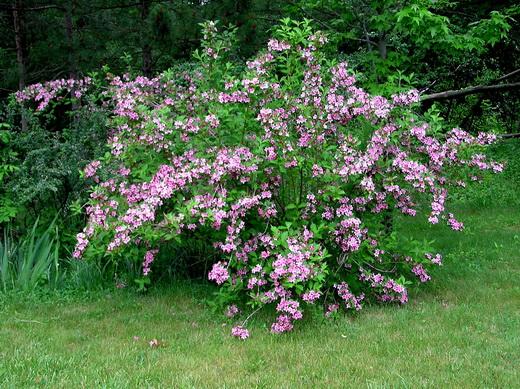
Propagation of all varieties flowers are produced by seeds, rooted cuttings, layering or dividing the bush:
- When planting seeds, you can expect flowering only after 5 years.The property of seeds to lose germination very quickly makes this process quite labor-intensive. They ripen only in late autumn and tend to produce a heterogeneous set of offspring, which gives an advantage to the vegetative method of plant propagation. The easiest option for seed propagation is to leave them alone and wait for spring shoots. Then leave the strongest shoots and deal only with them.
- Cuttings for rooting are cut in early June before the formation of flower buds for the next season. Semi-lignified cuttings should be approximately 12 cm long and have two pairs of true leaves. After treatment with heteroauxin, they are placed under a film, and the following spring they are planted in a permanent place. The plant blooms in the third year. It is recommended to pick off the first buds. It is best to plant 3-year-old seedlings in a permanent location. If green shoots of the current season are used for vegetative propagation, then the leaves are completely removed, the cuttings are placed at a depth of 1 cm and covered with plastic bottles, creating the conditions of a mini-greenhouse. At the same time, they need to be ventilated and watered daily. Green cuttings take root very easily and a plant grown from them blooms within 2 years.
- The most convenient and fastest way to propagate hybrid weigela is the method of dividing the bush. You can always see what a flowering plant looks like and negotiate its purchase. Moreover, with careful transshipment you can replant it at any time. It is very convenient to propagate weigela by layering, for which you can use branches located near the ground.By bending and scratching the bark to treat it with a growth stimulant and covering it with soil, next year a full-fledged seedling will be ready, which, after being separated from the main bush, is ready for planting in its main place.
Various species of weigela are easily crossed and cross-pollinated, which is advantageously used in commercial breeding and sale. Therefore, you need to carefully consider what variety you want to grow in your home.
Pruning and feeding
Pruning and regular feeding of the plant are of great importance. The best time to prune weigela is immediately after flowering. This is done once every two years. Pruning is of a rejuvenating nature, in which old branches that thicken the bush are removed. You can even trim the bush completely if pests have been noticed in its bark.
He will recover well over the next season. But shoots that have frozen after winter are removed regularly every spring during sanitary pruning. The bush is formed in the summer after flowering, but young shoots have not yet appeared, which cannot be disturbed. It is on them that weigela re-blooms in autumn.
As soon as the snow melts, it is necessary to apply a complete mineral fertilizer, which includes the superphosphate, urea, and potassium components necessary during this period. After a difficult winter period, this is very important for subsequent flowering and foliage condition. The second feeding is carried out at the moment of formation of flower buds in June. The usual fertilizer consumption is based on 30 g of superphosphate and potassium sulfate per bush.
Nitrogen fertilizers It is not recommended to use during this period. They slow down the process of lignification of shoots and can create conditions for the appearance of rot.The third feeding is planned for the fall. It is very good to use wood ash as a fertilizer, which is always available at this time of year. Calculation of ash 200 g per bush. Phosphorus fertilizers received by the plant in the fall help strengthen the branches and make flowering abundant the following year.
When planting several bushes at once, it is necessary to maintain the optimal distance between them, equal to 1.5 or even 2 m, if possible. The size of the plant can reach 2 m in height, and even more in width, which must be taken into account when creating interesting landscape compositions.
Varieties of hybrid weigela

The remarkable quality of weigela to delight its owners with its flowers twice a year makes it increasingly popular among active amateur gardeners. The first flowering occurs at the very beginning of summer and lasts from mid-May to the end of June. Last year's branches of the bush are strewn with colorful flowers.
Because of them, the leaves are completely invisible. Second September bloom on this year's shoots it is not so abundant, but next to the bright colors of powerful autumn annuals it is also unforgettable and beautiful. Weigela flowers have different shades, changing during flowering from delicate colors to brighter and more saturated flowers.
The main shade of weigela flowers is pink, but there are varieties of white, yellow, cream, carmine red, and purple. The following varieties are especially popular:
- The Bristol Ruby variety comes in various shades of red. It was received in the USA in 1944. Depending on weather conditions, its flowering occurs in June or July. It can also grow in the shade of trees, which is of interest to owners of small plots.This is one of the few shade-tolerant, fast-growing varieties of hybrid weigela. For its rapid flowering, the main thing is a large amount of moisture and very nutritious soil. Requires good shelter for the winter. In compositions, it should be taken into account that red shades look better from a close distance. Therefore, next to a gazebo or bench, where people are often present, it will be especially in demand, and its flowers will create additional comfort.
- Weigela species flowering and Korean made it possible to obtain a wonderful Candida variety with snow-white flowers that maintain purity even when withering. The white color is clearly visible from afar, and therefore any passerby will stop his admiring gaze when passing by an area with a bush, 2 m high, all the branches of which are strewn with flowers for three weeks. Such a plant is undoubtedly the pride of the owner.
- Pierre Duchartre, Marc Tellier, Styriaca, Newport Red, Rosea, Fieri Lemoine, Eva Rathke and many other varieties are worthy of planting.
Among the weigel groups there are plants with different leaf colors, tall, dwarf, and variegated. By planting ferns, hostas, and a bright carpet of annuals next to them, you can create unforgettable corners in your own garden, even in a small area. As the whole family admires this beautiful bush with bells, you can actually hear their mysterious grateful sounds.
Subtleties of planting weigela on video:
Interesting information about the vegetable garden

